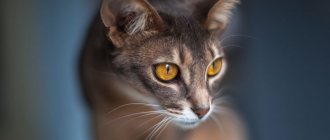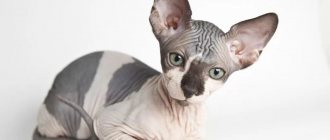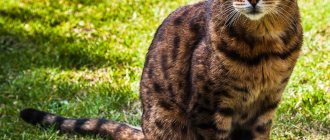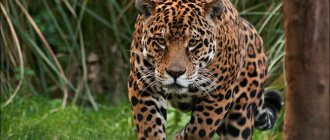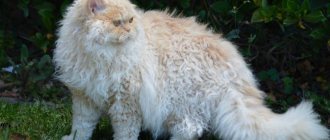Manul
Pallas's cat (Otocolobus manul, Pallas's cat) belongs to the subspecies of small cats and is included in the Red Book because it is an endangered animal. The beautiful thick fur of this predator (up to 7 cm in length) of gray or reddish-brown color with silver tips has made it a desirable prey for hunters for valuable fur. This fur saves animals from frost in their natural habitats. This species of feline hunts birds, hares, marmots, mice, badgers, lives for about 10 years, weighs about 5 kg with a length of 65 cm, and reproduces in the spring.
If you are seriously considering bringing a Pallas's cat into your home, check out the arguments against it:
- Manul is a nocturnal hunter, so he won’t let you sleep at night.
- This type of cat loves space; it is not suitable for keeping in an apartment; it needs a large yard.
- Sheds heavily.
- While playing and sharpening its claws, the animal will ruin all the furniture and curtains in the house.
- He has an aggressive character; neither other pets, nor you, nor your children will get mercy from him.
- It is unlikely that you will be able to find a cat to mate with, or vice versa, and the hormones playing in the spring will drive him into rage and severe aggression.
- Veterinary medicine is not very familiar with Pallas' cats, so in case of illness, it is unlikely that you will be able to find a veterinarian who can cure it.
- You will have to think carefully about the cat’s diet so that he does not get sick and develops properly; regular cat food will not suit him.
- This animal is listed in the Red Book, therefore it is not sold legally, and an illegally imported cat is very expensive (up to 6.5 thousand US dollars), may be infected with some disease or exhausted and exhausted.
There are several reviews on the Internet of people who have domesticated Pallas's cat, but they all note the evil nature of the animal.
Bengal cat
Nothing more than a domestic mini-leopard, which was obtained by crossing a wild Bengal cat and a domestic one.
.
The history of the breed began in the USA in 1961, and its author was Jean Mill. By education, the girl was a biologist-geneticist. Even in her student years, she dealt with the issue of crossing a Siamese and a Persian. The result should have been a panda cat.
The panda was not destined to be born, but a Bengal cat was born, outwardly similar to a leopard with a strong body, spotted color and beautiful short hair.
The breed is actively used to create new ones and develop long-haired versions.
Sandy (dune cat)
The sand cat lives in the deserts of Tajikistan, Kazakhstan, the Arabian Peninsula, Uzbekistan, and Morocco and is one of the small breeds of wild cats. The length of the cat without a tail is only 40 cm, its height is no more than 25 cm, and the animal weighs a little more than 3 kg. It has a very thick and very short coat of yellow or cream color, even the soles of its feet are covered with hair. Feeds on small animals. Due to its low population (about 50,000), the sand cat is listed as a protected animal.
Did you know? A sand cat may not drink water for several weeks, hiding in cool places on a hot day.
The following facts speak against your decision to domesticate a sand cat:
- She needs a lot of space, otherwise she may get sick and die.
- There should be dry, warm air in the room.
- The meal should include different types of meat.
- There are only 9 sand cats in the world kept in captivity in zoos, they are great masters of camouflage, making them difficult to catch.
- They have been little studied and are difficult to treat.
- The sand cat will not leave food uneaten, he will hide it: in natural conditions he will bury it, in domestic conditions he will shove it under your pillow or in the sofa.
- It is prohibited by law to catch and keep sand cats at home; an illegally imported animal costs more than 5 thousand US dollars.
Increasingly, exotic animals are chosen as pets: lemurs, salamanders, crocodiles, leopard geckos, snails, iguanas, chameleons, squirrels and jerboas.
Spotted ginger cat
She belongs to the genus of Asian cats. It can be found in India and Sri Lanka. The rusty cat is endangered; there are only about 10 thousand adult individuals in the world. Its length is from thirty-five to forty-eight cm, and its tail is from fifteen to thirty cm. An adult cat of this breed weighs 0.9 -1.6 kg.
Externally, the Spotted Red cat resembles a Bengal; its coat is gray, but it has “rusty” spots. The belly is light. They lead a solitary lifestyle and go hunting at night. They feed on mice, lizards and various insects. They spend a lot of time on the ground, although they can climb trees.
These cats give birth to one to three cubs, but most often one baby is born. The number of these animals is constantly decreasing, because... their habitat changes.
2 0
Caracal
The steppe lynx (caracal, Lynx Caracal) naturally lives in the sands of the Arabian Peninsula, Asia, Africa, and near the Caspian Sea. These are big cats, the height of a wild animal is about 50 cm, and the length is about 1 m, the cat weighs up to 20 kg. Its fur is thick and short, light brown or brown in color, velvety to the touch, and has black tassels at the tips of its ears.
Important! The caracal is a large animal; in nature, its prey is antelope, so it
can easily kill your child.
These cats also feed on foxes, hares, birds, scorpions, and hedgehogs.
If you decide to keep a caracal, you will have to:
- Build for him a spacious enclosure with special toys, which will definitely have a roof on top, otherwise the cat will simply jump over it.
- Find a veterinarian who can treat him and trim his nails.
- Walk him with a muzzle 2 times a day.
- You can tolerate a dirty cat because you won’t be able to give it a bath.
- During the period of a hormonal surge, endure anger and smell the strong smell of urine, with which the entire apartment or house will be marked.
- Endure pogroms in the house.
- Give up to 800 g of various meats daily for 20 years.
- Pay 10 thousand US dollars for it.
Reproduction: mating cycle
Each species of wild cat, be it a forest cat or a tropical wild cat, prefers solitude and seeks company only during the mating period. Males mark their habitat with a specific-smelling secretion from the anal gland. The boundary of a wild cat’s territory varies from 1 to 2 hectares; during the rut, in search of a prospective female, they can go far beyond the marked area and are often exposed to the possibility of bumping into another owner of the seized land. This situation is fraught with “military actions” for the right to own territory and the female, as a rule, the strongest wins. The cat breeds 1-2 times a year, kittens are born in numbers from 3 to 7. The first lambing occurs in the summer months, the second - at the end of December. The male remains with the female to raise a new generation until the babies begin to eat on their own, then the male representative leaves, leaving the offspring to the mother.
Savannah
This breed was created artificially by crossing a serval with a domestic cat. And there is one nuance: until the fourth generation, males cannot give birth, and with each generation, the genes of the domestic cat begin to predominate more and more, so only the first generation is valued. This animal has large ears, high paws, and swims well. Savannah grows up to 60 cm in height and up to 1.3 m in length, weighing about 15 kg. Its fur is short and thick, with black spots, and its color is yellow, tan or gray.
Disadvantages of keeping a savannah at home:
- She must be walked on a leash and muzzle.
- She needs a spacious yard.
- She has a highly developed hunting instinct and can eat other domestic animals.
- If the Savannah gets into the bathtub, it will be difficult to get her out of there, not only because of the weight, but also because she will not want to get out, since she loves to swim.
- The male will mark the room, and the smell will remain the same.
- You won't be able to go on vacation or take a day off - the savannah doesn't tolerate strangers.
- If you take a couple of Savannahs in hopes of breeding, it may not work out. In addition to male infertility, there is also this problem: a couple must live together for a very long time before they want to reproduce.
- Savannah sheds heavily.
- Does not tolerate cold well.
- Savannah should be fed raw meat, vegetables and fruits.
- The price of a first-generation Savannah is about 20 thousand US dollars.
Is it easy to keep a wild cat at home?
What you need to know about caracal
The steppe lynx, or caracal, is a fairly large animal: its length is about a meter, the height at the withers can reach 50 cm, and its weight is 15 kg. In nature, this animal lives in savannas, steppes and deserts of Asia and Africa, settling in small gorges and other people's burrows. The caracal is active mainly in the dark, when it goes hunting, although it is capable of hunting during the day. It is very strong and resilient, can go without water for a long time, easily climbs trees and jumps several meters in length - in general, a typical large predatory cat.
In ancient times, Asians sometimes domesticated caracals and used them as assistants when hunting hares, pheasants and even small antelopes, but this practice was later forgotten. Now the steppe lynx is once again considered as a friend of man, and this time as a full-fledged pet.
Content Features
An ordinary city apartment is not at all suitable for keeping a caracal. A large cat needs a large room with a separate area of at least 15 square meters. Therefore, it is recommended to own a caracal for those who live outside the city in a private house or at least in a very large apartment, having the opportunity to allocate a separate room for a pet predator with a scratching post and a climbing frame (not a cat’s one, of course, but a larger and more durable one).
The caracal needs to move a lot, so ideally its home should look like this: an enclosed space with an adjacent open enclosure and the opportunity to walk freely in the fresh air (ideally, around the garden). It is clear that you need to arrange everything in such a way that the animal cannot leave your site.
When they reach adulthood, male and female caracals often begin to mark their territory, and you need to come to terms with this or castrate or sterilize your pet (although this does not always help).
The caracal has thick hair with a good undercoat, therefore, like any cat, it needs to be thoroughly combed at least once a week. But private bathing is not recommended.
Feeding your pet
Caracals are usually fed with fresh (not boiled!) broiler chickens, quails (always with feathers and bones), rodents and raw beef. But it is not recommended to give industrial cat food (even intended for large breeds of cats) to these animals. It is also extremely undesirable to give the steppe lynx fatty types of meat - for example, pork and lamb. You can offer the caracal fresh fish, after selecting all the bones from it. In addition, vitamins must be added to your pet’s diet.
Kittens are usually fed twice a day, and adult pets - once. Therefore, the one-time amount of food must be impressive, based on the large size of the animal.
After eating the bird, the room in which the caracal ate will be filled with feathers, blood, and bones. The future owner must understand that he will have to clean it all up every day.
Character of the caracal
If your animal was purchased from a good nursery and raised properly, it will not cause you any trouble. Such caracals are balanced in character, obedient and friendly towards their owners (although they may be distrustful of strangers). By nature, they are very playful and active, and the owner needs to take into account such a high activity of the animal and be careful, not letting it play out too much. Be prepared for the fact that a large cat may scratch or chew furniture upholstery or wallpaper, or accidentally knock over some unstable object in the room.
Steppe lynxes, raised close to humans since childhood, although independent, like any cat, are very affectionate and loyal. A domestic caracal with a stable psyche will never intentionally attack anyone or show aggression, but if there are small children in the house, it is better not to have such a large animal for obvious reasons.
If you want to buy a maximally socialized cat, it is better to do this in a domestic cattery, whose animals are constantly in contact with people. However, even in this case, no one will give you a 100% guarantee that the caracal will have an ideal and flexible character. As for intelligence, these animals are very smart. They easily get used to the tray and, with proper training, are able to come to the owner’s call, respond to their name, and even carry out simple commands.
If you keep a caracal in the city and are going to walk it on the street (and long walks are vital for it), you should only lead it on a leash.
And, of course, before getting such an animal, you need to think a hundred times and weigh the pros and cons, and also realistically assess your financial and physical capabilities. And remember: after all, this is a wild animal with all the attendant risks.
Dear readers!
Send your questions and suggestions to [email protected]
Ocelot
This predatory cat (field tiger, Leopardus pardalis) lives in the tropics of America and is similar to a leopard. He has a large head, strong paws, and well-developed muscles. The ocelot grows up to 0.5 m in height and up to 1.5 m in length, and weighs about 15 kg. The fur is very thick and short, light brown with black spots, white on the belly and neck, black ears, each cat has an individual pattern. Their population is endangered.
You should avoid breeding ocelots at home for the following reasons:
- The ocelot has a secretive nature and will not need your company.
- An ocelot will need about 0.5 kg of raw meat per day.
- For better taming, you should take a kitten that is still blind and feed it using a pacifier.
- For maintenance you will need a very high enclosure with an area of at least 15 m2 with a pool and trees.
- The ocelot marks its territory and does not allow anyone into it.
- He doesn't get along with other animals.
- Capable of harassing you with mating cries.
- The hunting instinct is well developed.
- A very proud cat.
- The cost of an ocelot is about 4 thousand US dollars.
Important! An ocelot should not be given raw pork; it may get sick and die.
Iriomotean cat
This is a subspecies of the Bengal cat that lived on the small island of Iriomote, located near Taiwan. For a long time, the Iriomotean cat was considered a separate species. It was discovered in 1965.
The length of a cat with a tail is from seventy to ninety cm, and it makes up about 25% of its length. It weighs from three to five kg. It is dark brown in color, with small dark spots, which then merge into stripes. The animal prefers a nocturnal lifestyle, and during the day it hides in secluded corners. Prefers a solitary life. It feeds on rodents, waterfowl and crabs.
Now the number of these animals is rapidly declining, because... The meat of the Iriomotey cat is considered a delicacy among the local population. There are now less than 100 individuals.
Asian leopard (ALK)
These predatory cats live alone and are common in tropical forests in many Asian countries. Externally, in accordance with the name, they are similar to a leopard, but the size of a domestic cat - no more than 8 kg in weight and 40 cm in height, although there are also larger animals. The color of the coat is different, from yellow to gray, with black spots.
Disadvantages of domestication:
- Aggressive behavior during sexual desire.
- The temperature for keeping should not be lower than 20°C.
- You need to play with the animal, it should have a lot of toys.
- The Asian Leopard Cat should eat 1 live rat or two mice every day.
- Needs walking.
- The animal is very jumpy, your curtains will be torn and your vases will be broken.
- You need to adopt a small kitten.
- These cats are monogamous and live in pairs all their lives.
- Cost - about 4 thousand US dollars.
It is best to have cats at home of the following breeds: Scottish Fold, Munchkin, Burmese, Persian, Siamese, Burmese, Ragdoll, American Curl and Masquerade.
Pampasskaya
This cat is also called the grass cat (Leopardus pajeros), lives in nature in the steppes of South America, is similar in size to its domestic relative, but looks larger. She has long hair (up to 7 cm) of gray, yellow or brown color, black or dark ears, a thick and long tail, and large ears.
Reasons why it is better not to keep her at home:
- The Pampas cat does not allow anyone into its territory.
- Leads a nocturnal lifestyle.
- Little studied.
- Prefers privacy.
- He steals all the birds from his neighbors.
- Doesn't adapt well to domestication.
- Listed in the International Red Book.
- The cost is about 1,000 US dollars.
Geoffroy
Geoffroy's cat (fishing cat, Oncifelis geoffroyi or Leopardus geoffroyi) lives naturally in the grassy areas of South America. She has a light color with black spots, black stripes on her head, and is about a meter long with a tail.
Disadvantages of taming Geoffroy:
- This is a very dangerous and intelligent predator with incredibly sharp claws.
- Likes to hide leftover food.
- Can breed at any time of the year.
- Does not breed in captivity.
- Costs 20 thousand US dollars.
Did you know? Cats get drunk not only from valerian, but also from mint, elderberry and thyme.
Serval
In the wild, the serval (bush cat) lives in Africa. This is the longest-legged cat in the world, he has the largest ears. The length of the cat with tail is up to 1.5 m, height is up to 60 cm, weight is about 16 kg. The color of the coat is similar to that of a cheetah - white below, light brown above with dark spots.
Of all the wild cats, the serval is the most amenable to domestication, however, certain dangers lurk here:
- May climb into the toilet to play with water, or break a vase of flowers.
- Should be adopted at two months of age and bottle fed.
- Marks territory and has a strong odor.
- Loves to climb on closets.
- Requires a large area.
- May severely scratch or bite a child.
- He cannot be hit or stopped by shouting.
- While playing, it can scratch you badly.
- Doesn't tolerate strangers well.
- Eats more than 1 kg of raw meat per day.
- Likes to hang on anything.
- May chew shoes and electrical cords.
- Needs a lot of toys.
- May become entangled and strangled in the collar.
- Being small, he can jump from a height and break his legs.
- Lives for about 20 years.
- A serval costs 7-8 thousand US dollars.
History of the origin of the breed
The history of the origin of the bush cat is entirely due to evolution. The man went further and helped the serval hybrids to be born. But more on that later.
global $ads_google; //data-ad-slot=”2475549904″ $ads_google = empty($ads_google) ? false : true; ?> if ($ads_google == false) {?>
$ads_google = true; ?> } ?>
Servals live in Africa, except the Sahara Desert, in the forests of the equatorial zone and in the south, in the Cape Province. It is rare to see a wild serval near Algeria, Morocco. In Tanzania, in the Ngoro-Ngoro crater, there are a lot of these animals. About 40 representatives of the breed live there per 100 m2.
In the wild, animals settle near a source of water. Therefore, keeping the house turns into searching for water and playing with it. The animal greets the rain joyfully, then happily running its wet paws across the floor and beds. Ancestor genes!



